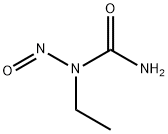N-Nitroso-N-ethyl urea is a pale yellow, crystalline
powder; freezing/melting point=103-104°C
(decomposes). Hazard identification (based on NFPA-704
M Rating System): Health 2; flammability 1; reactivity 0?.
Soluble in water; hydrolysis produces explosive gas.
N-Nitroso-N-ethylurea has been used as a mutation-inducing agent.
A precursor of Diazoethane
Experimentally as mutagen; ethylating agent.
ChEBI: A member of the class of N-nitrosoureas that is urea in which one of the nitrogens is substituted by ethyl and nitroso groups.
Yellow-pink crystals or off-white powder. Sensitive to light.
Water soluble. Sensitive to moisture--stability in aqueous solutions depends on pH.
N-NITROSO-N-ETHYLUREA is highly reactive. Sensitive to moisture and light. Its stability in aqueous solutions is pH-dependent. Incompatible with water and nucleophilic reagents. Alkaline hydrolysis produces a highly explosive gas. .
Tumorigen, carcinogen, neoplastigen; teratogen; poison; toxic.
ACUTE/CHRONIC HAZARDS: N-NITROSO-N-ETHYLUREA is extremely unstable at high pH. It will decompose to extremely unstable decomposition products if acidic conditions are not maintained. When heated to decomposition it emits toxic fumes of nitrogen oxides. Decomposition products may be explosive.
Flash point data for N-NITROSO-N-ETHYLUREA are not available; however, N-NITROSO-N-ETHYLUREA is probably combustible.
DNA alkylating agent that is carcinogenic in many animal species. Induces benign and malignant tumors of numerous types, including the nervous tissue, stomach, esophagus, pancreas, respiratory tract, intestine, lymphoreticular tissues, skin, and kidney.
Confirmed carcinogen
with experimental carcinogenic,
neoplastigenic, tumorigenic, and teratogenic
data. Poison by ingestion, subcutaneous,
intraperitoneal, and intravenous routes.
Human mutation data reported. When
heated to decomposition it emits toxic
fumes of NOx. See also N-NITROSO
COMPOUNDS.
Used as a chemical intermediate for
dyes and pharmaceuticals; a polymerization inhibitor during
the manufacture of vinyl monomers such as styrene; a
precursor of diazoethane; accelerator for rubber vulcanization.
N-Nitroso-N-ethylurea is reasonably anticipated to be a human carcinogen based on sufficient evidence of carcinogenicity from studies in experimental animals.
Toxic solids, organic, n.o.s., Hazard Class: 6.1;
Labels: 6.1-Poisonous materials, Technical Name Required.
UN3077 Environmentally hazardous substances, solid,
n.o.s., Hazard Class: 9; Labels: 9-Miscellaneous hazardous
material, Technical Name Required.
N-nitroso-N-ethylurea is highly reactive.
Sensitive to moisture and light. Its stability in aqueous
solutions is pH-dependent. Incompatible with water and
nucleophilic reagents. Alkaline hydrolysis produces a
highly explosive gas. This compound is extremely
unstable at high pH. It will decompose to extremely
unstable decomposition products if acidic conditions are
not maintained. Nitrated organics range from slight to
strong oxidizing agents. If mixed with reducing agents,
including hydrides, sulfides and nitrides, they may begin a
vigorous reaction. Reaction with
Consult with environmental
regulatory agencies for guidance on acceptable disposal
practices. Generators of waste containing this contaminant
(≥100 kg/mo) must conform with EPA regulations
governing storage, transportation, treatment, and waste
disposal.
